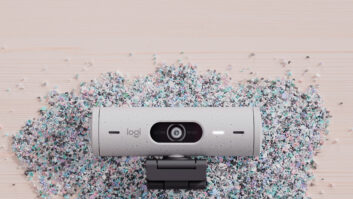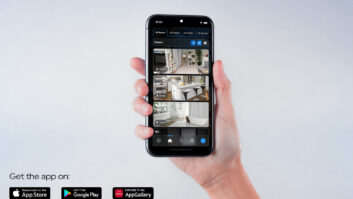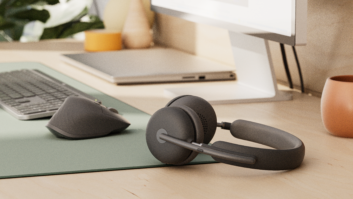
NEW YORK — PC peripherals industry stalwart Logitech was struggling to keep afloat when Bracken Darrell came on as president in April 2012 and CEO in January 2013. The declining computer market was hitting the company hard, and it faced the task of undergoing an evolution or risk sinking along with those desktops. A little more than three years later, Logitech has been reinvigorated, with a bright future in the tablet accessories market, helmed by a leader who told TWICE he’s “having the time of his life.” We spoke with Darrell, a former Whirlpool, Procter & Gamble and GE exec, and a 2014 TWICE Newsmaker of the Year, about Logitech’s turnaround and its plans for the future.
TWICE: Logitech has tripled its profits over the last two years. Are you still in official turnaround mode or has the roadmap changed?
We’re absolutely not in turnaround mode. We’ve tripled our profits.
We’ve got the highest earning per share in seven years. If you look at the business in constant currency, and then you look at just our retail and e-tail business — excluding OEM and LifeSize, which are different animals — we were declining 8 percent a little over two years ago, and then last year we grew [6] percent. We’ve really flipped. Now it’s all about becoming a growth company.
TWICE: You’ve begun referring to Logitech as a design company, which wasn’t something explicitly designated in your initial turnaround strategy. How did you come to take that tack?
I’m now old enough to have learned that you don’t always go out and say exactly what you intend to do. Sometimes it’s better to just do what you want to do and explain it after the fact, and that’s essentially what we did. I knew design would be center of the game plan when I came into the company but I didn’t share that very broadly with a lot of people. But I immediately started hiring the chief design officer, and we immediately started building design principles we’d operate by and then staffing up design. … I think Logitech was always pretty good at design. We didn’t have any conventionally trained designers in positions, but we’ve always done a good job at design.
I ran the Braun organization out of Germany from 2004 to 2008, and if you know anything about Braun, you know that it was really a design company originally. … That point forward I decided that I wanted everything I did to have something to do with design.
TWICE: Consumer perception of products certainly seems to have changed from the somewhat stodgy image of PC peripherals vs. the tablet accessories available now.
I think the consumer perception of a product they use for an iPad is different than the one they use for a PC. I’m not sure it actually has to be, but it’s the way we played it. We played it in a more functional role for the most part in PC peripherals. The key to tablet accessories is that people want to carry it around. They want people to see it. They need it to be beautiful, amazing and functional. It gave us a chance to really create something that’s both beautiful and functional, and I love what we started to do in tablet accessories because I think it’s a little foreshadowing for what we’re going to do on everything else downstream.
TWICE: What was the biggest challenge throughout the turnaround process?
In the beginning of the turnaround the biggest challenge, as it always is, was we needed to get our costs right. Our cost had gotten ahead of us. We had to do a restructuring; we had to reduce the number of employees. That was the worst thing we had to do.
In terms of the biggest challenge — and I don’t know if it really was challenging; it was actually a lot of fun — was starting to put the right players in place and products in place. We were and will always be all about products. … That will always be the challenge — making sure we deliver something that’s differentiated and superior. When I came in, we just didn’t have portfolio that was compelling as Logitech should have. Now we do, and now we’re back. And we’re just getting started.
TWICE: The biggest surprise? I hate to sound blasé about it because I’m not at all, but the thing that surprised me the most was how consistent what I thought we’d be able to do has been. What I envisioned we could do, we’ve actually done — we’re maybe even a little ahead of how fast I thought we could do this. I guess I’m surprised by that. I’m not the kind of person to ever be anything but paranoid and thinking into the future. To say I’m surprised we’ve gotten as far as we have as fast as we have — you shouldn’t interpret that as being comfortable with the future. I’m totally uncomfortable all the time! [laughs] I just never feel like we’re moving fast enough. We are ahead of what I thought we could do, but we’re not ahead of the pace of the world around us.
We’ve got to just keep accelerating, and risk managing so we don’t make any big mistakes. Keep pushing ahead into new categories and developing new products. It’s an incredibly exciting place to be, but we just can’t relax. We’ve got to really go, go, go.
TWICE: You’ve said one of your largest focuses going forward will be on retail strategic business growth. Can you detail what you meant by that?
OEM is 5 percent of our business, and we’re exiting it. LifeSize is 5 percent, and it’s really very independent and we’re refocusing on the B-to-B segment. When we say retail strategic, it’s all the businesses you know us for, such as PC peripherals, and the ones we’re getting into [like] Bluetooth speakers [and] tablet accessories. We’re reinvesting in PC gaming. The last business is video collaboration, a new business we created 2.5 years ago. It’s essentially low-cost video conferencing that’s taking advantage of all the video-conferencing Cloud services like Google Hangouts. What we sell is the equipment you use to enable that.
Our strategy is pretty simple. We’re optimizing profitability in our PC peripherals business. We’ve moved a lot of resources from PC peripherals into growth categories, and we’re also working on six or seven new [growth categories]. I don’t know if they will all launch. We’ve killed a couple; we’ve added a couple. They’re sort of secret projects that are staffed like start-ups. We’ve got different kinds of people running them. It’s like a learning lab as well as a creation lab. We’ll enter new categories over time, although we’re not ready to share right now. It’s really exciting and I don’t think a lot of people totally understand that — and I don’t mind that. It’s kind of like design: Let’s do it and then we’ll talk about it.
The other thing is that we’ve already done this. Tablet accessories, Bluetooth speakers and video collaboration essentially didn’t exist for us three years ago, and today they’re almost $400 million in sales. So we’re creating the categories now, and it’s our intention to keep doing that and to sustain the growth on the ones we’ve created. It’s a cool, fun strategy.
TWICE: You intended and then changed your plans to sell off the remotes and video-security divisions. Has there been any update with those plans? Home automation seems to have reinvigorated your Harmony line.
[The Logitech digital video security] platform is really not designed for home control like you’re seeing now. It’s a very expensive platform. We’re taking care of our existing customers, but we’re really shutting that down.
In Harmony we didn’t find anyone willing to pay what we thought it was worth, and so we doubled down. We restructured. We made it profitable, and we changed the strategy. We’re really expanding the definition of what a remote can do. We’re just getting started there, and, no, there are no plans to sell it — at all.
TWICE: Logitech will no longer make PC peripherals for third parties. What prompted you to exit OEM, and are you worried about the impact it will have?
We started as an OEM supplier, and some years in the OEM suppliers decided they would just go direct to the Chinese manufacturers. So we launched our own brand. Thirty-four years later, what used to be 100 percent of our business became 5 percent of our business. What used to be all of our profits became almost none of our profits. We used to be a company that made things for everybody else to create their brands with; now we’re really creating our own brands with our own technology and design. It just doesn’t make sense to be in OEM anymore — it’s not profitable and it’s not growing.
TWICE: Do you have plans or intentions about participating in the Apple Watch accessory category? Do you see a potential market for Logitech there?
I have two Apple Watches right now, and I hope it’s the beginning of a love affair. It’s too early for me to say whether we’ll have accessories for it.
TWICE: How do you think the launch of Windows 10 will affect Logitech and the PC accessories market in general? Are you preparing for an uptick? Have new OSs traditionally resulted in increased sales?
It’s hard to say. Sometimes they do, sometimes they don’t. If it does have a big uptick, we’ll be ready for it. If it doesn’t, it won’t have an effect. We don’t plan for it that way. We make sure all of our products are compatible, and they are. We’re ready to go.













